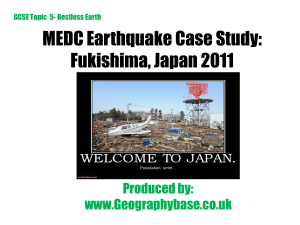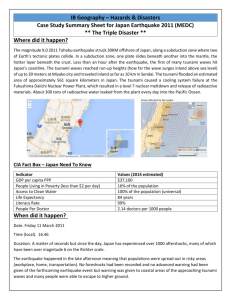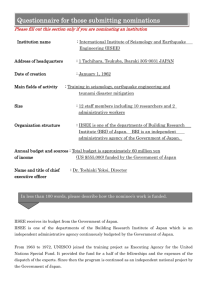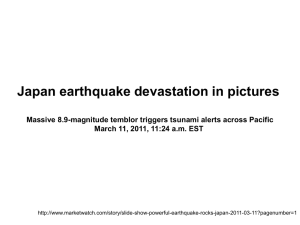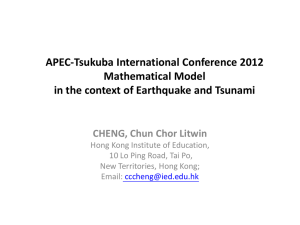Earthquake Case Study Japan 2011.ppt
advertisement
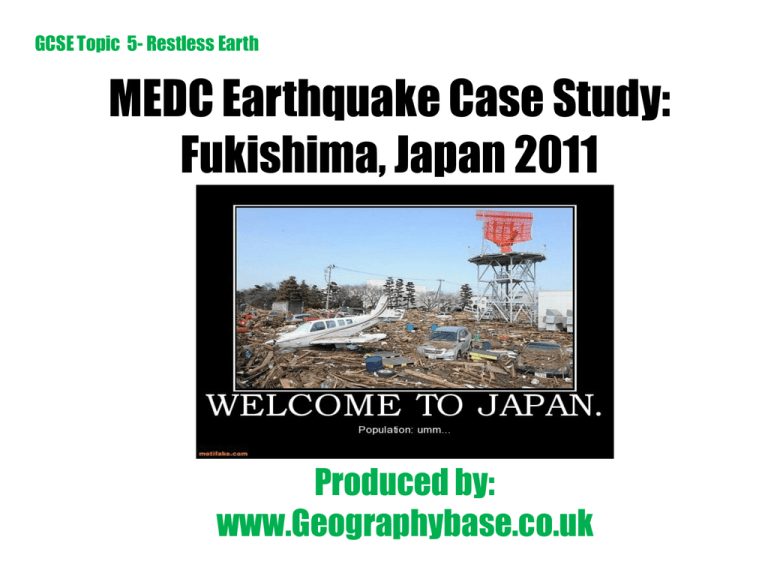
GCSE Topic 5- Restless Earth MEDC Earthquake Case Study: Fukishima, Japan 2011 Produced by: www.Geographybase.co.uk Background Info: • The Earthquake occurred on 11th March 2011 at 2.46 PM (local time) • It measured a catastrophic 9.0 on the Richter Scale. • It is the largest Earthquake to be recorded in Japan in living memory. • It was responsible for the loss of roughly 15,400 lives. The Causes: • Japan is located on the eastern edge of the Eurasian Plate. • The Pacific Plate, which is an oceanic plate, subducts (sinks under) the Eurasian Plate, which is a continental plate, to the east of Japan. This type of plate margin is known as a destructive plate margin. • The process of subduction is not smooth. Friction causes the Pacific Plate to stick. In the case of Japan pressure built up and on 11th March 2011 this pressure released as an intensely strong earthquake and a Tsunami with waves of 30 m, travelling at a colossal speed of 800 Kilometres per hour, which is equivalent to the ground speed of a jumbo jet. • The Nearest City to the epicentre was sendai (130 Km east of Sendai). Primary Impacts: • • • • • • • 15,400 People were killed. 2 Million People were left homeless as a result of the Tsunami. 4 Trains were swept away from their Tracks. A Cruise Ship, carrying 100 people was washed away by the sheer force of the waves. A dam in the north of Fukishima prefecture burst its banks, which caused many more homes to be swept away. Power lines and Gas and water services were severely disrupted, as the earthquake ruptured under-ground cables and pipes. The Public telephone system was knocked out, with no signal for mobile phones and internet. Secondary Impacts: • • • • • • • 500,000 People were forced to live in shelters. The disruption caused to rail and road links meant that it was hard for rescue teams to reach places where it was needed. The damage to the underground gas pipes led to fires which spread quickly and ignited wood carried by the wave. As Clean water was scarce, water-borne diseases such as Cholera and Typhoid spread rapidly. The earthquake caused a power cut at Fukishima Daiichi nuclear power plant which caused a failure in its cooling system, and subsequently caused radioactive materials to escape, causing local radioactivity levels to increase up to 40,000 times than normal. This will for years to come have a long lasting impact on the health of the local people. This Catastrophic disaster had many serious impacts on Japans economy as on 12th March, Japan lost over £90 billion in its shares. The Total Cost to re-build the areas affected was set at £185 billion. Short-term Responses: • • • • • • Within minutes of the Tsunami, Japan alerted its emergency response teams. An estimated 100,000 people began the disaster relief mission. The Japanese Red-Cross mobilised 230 emergency teams to the worst affected areas to provide medical and moral support to victims. On 2nd April, Japan and the USA joined forces to search for bodies along the eastern coast. Shelters were set up in schools for those who lived in close proximity to the Fukishima Daiichi nuclear power plant. Many NGO’s (Non-governmental organisations) responded to the hazard. For example: Shelter box sent 1,500 boxes of aid (Tents, Sleeping bags and bottled water) within the first month of the disaster. Long-term Responses: • • • • In March, Japan’s Meteorological agency issued an earthquake warning, followed by a Tsunami warning. This meant that many people were able to escape to higher ground, but the short time (20 minutes), meant that thousands could not escape. The Japanese government responded to this disaster by questioning their huge walls and Tsunami floodgates as they did not prove to be very effective. The Government also responded to this disaster by reviewing their methods on predicting earthquakes and tsunamis as well as cutting short the time between the disaster and the response by improving communications and Sirens. Factors affecting the damage caused: • • • • • Strength & Depth of the Earthquake: As the earthquake was a mighty 9.0 on the Richter scale, the damage was bound to be severe. Also the point at which the earthquake happened (The FOCUS) was relatively shallow (30 KM deep), which is the reason why the Tsunami travelled at such speed and caused so much damage. Population density: As the epicentre of this earthquake was in close proximity to sendai, a largely populated city, the damage caused was far greater as there are more potential fatalities such as, falling skyscrapers and Leaking oil pipes. Type of buildings: As Japan is on the “Ring of Fire”, most of the buildings are “Quake-safe”, although there are less than there are in Tokyo, which is why the damage was vast. Time of Day: As the Japan Earthquake occurred at 2.46 in the afternoon, there was more damage than there would of been at 7.00 in the evening as there are more people in commercial and industrial areas in the day. Alternatively, this earthquake could have caused even more damage if it occurred in the evening, when less people are aware and alert. Secondary Hazards: The Death toll could of also been inflated in Japan because of the subsequent Tsunami caused which completely drowned the eastern coast of Japan, which lead to death by water-borne diseases as well as drowning and Fires. Disaster Risk Assessment = Natural Hazard x vulnerability Vulnerability (ability to cope) Inspirational Quote: “we don’t know the number of victims, but I Pray that every single person can be saved”. (Japan’s Emperor Akihito) PPQ! • Answer the following Question in your exercise book: Q. “Describe the causes, the immediate and Long-term effects of an Earthquake in a rich part of the world that you have studied.” [8 Marks] Extension Tasks: Choose ONE of the Tasks below: Task 1: Write a diary entry, dated 13th March 2011 pretending you are one of the victims of the Japanese quake. Write clearly, the fears and any difficulties that you faced. Task 2:suggest why some individuals or communities may underestimate the probability of hazard events occurring. Please note: These are not exam-style Questions, but simply extension tasks that will broaden your understanding of Natural disasters.

